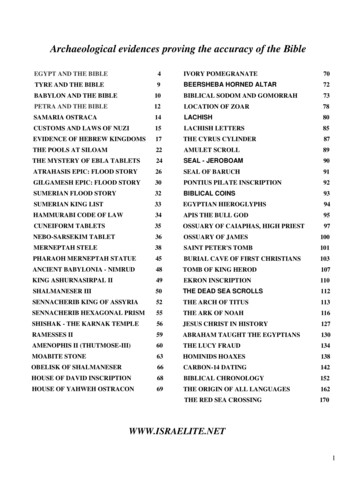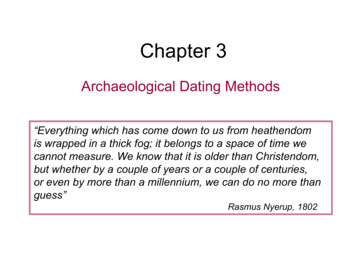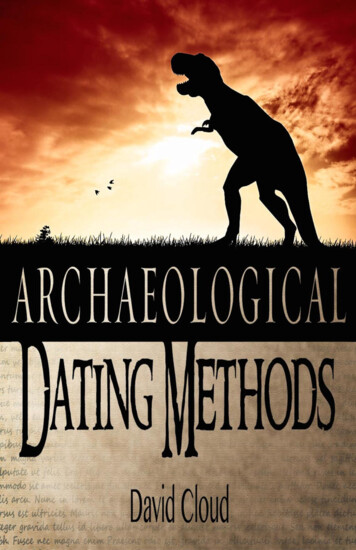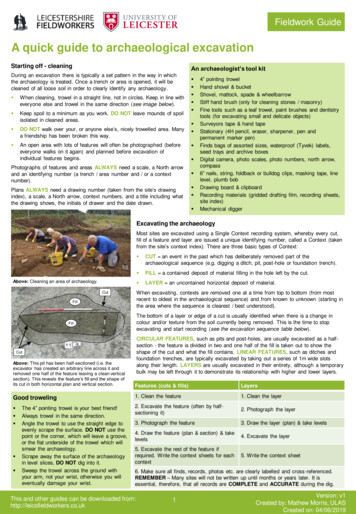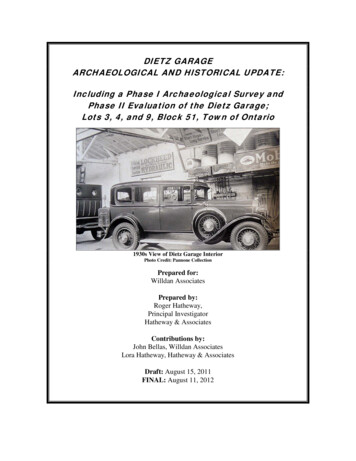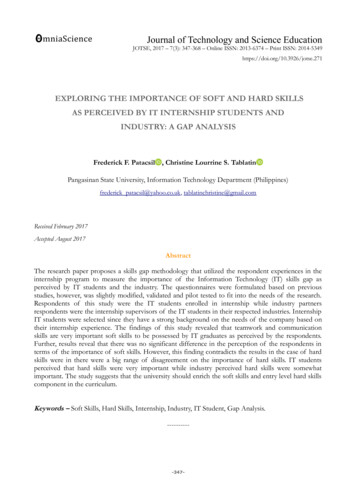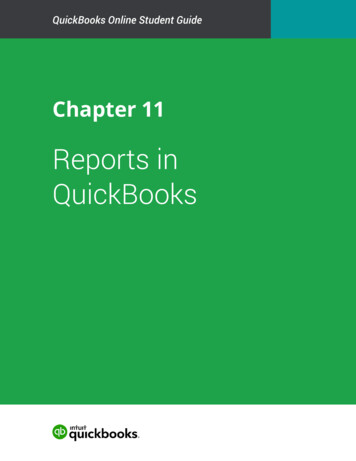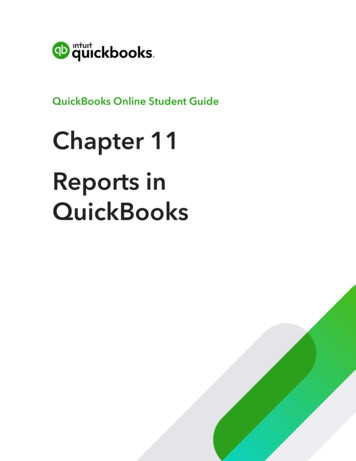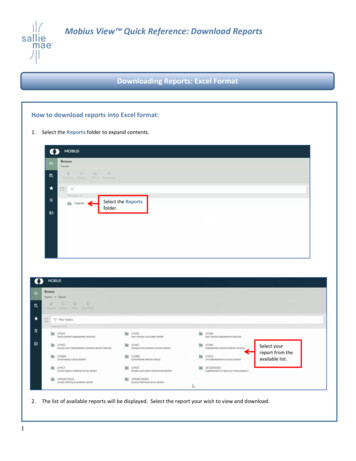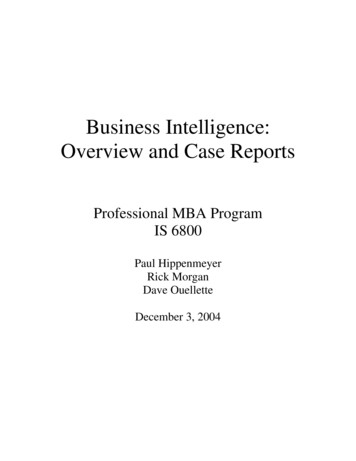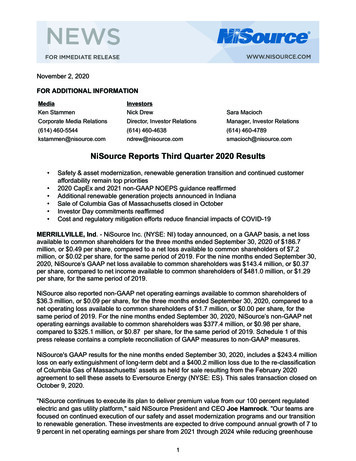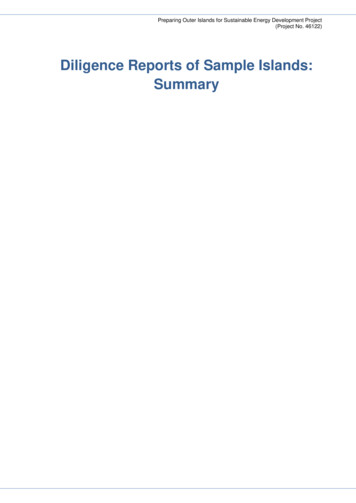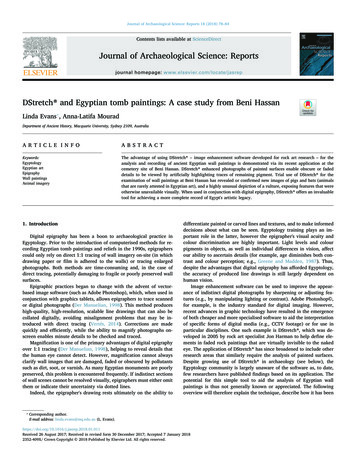
Transcription
Journal of Archaeological Science: Reports 18 (2018) 78–84Contents lists available at ScienceDirectJournal of Archaeological Science: Reportsjournal homepage: www.elsevier.com/locate/jasrepDStretch and Egyptian tomb paintings: A case study from Beni Hassan⁎TLinda Evans , Anna-Latifa MouradDepartment of Ancient History, Macquarie University, Sydney 2109, AustraliaA R T I C L E I N F OA B S T R A C TKeywords:EgyptologyEgyptian artEpigraphyWall paintingsAnimal imageryThe advantage of using DStretch – image enhancement software developed for rock art research – for theanalysis and recording of ancient Egyptian wall paintings is demonstrated via its recent application at thecemetery site of Beni Hassan. DStretch enhanced photographs of painted surfaces enable obscure or fadeddetails to be viewed by artificially highlighting traces of remaining pigment. Trial use of DStretch for theexamination of wall paintings at Beni Hassan has revealed or confirmed new images of pigs and bats (animalsthat are rarely attested in Egyptian art), and a highly unusual depiction of a vulture, exposing features that wereotherwise unavailable visually. When used in conjunction with digital epigraphy, DStretch offers an invaluabletool for achieving a more complete record of Egypt's artistic legacy.1. IntroductionDigital epigraphy has been a boon to archaeological practice inEgyptology. Prior to the introduction of computerised methods for recording Egyptian tomb paintings and reliefs in the 1990s, epigrapherscould only rely on direct 1:1 tracing of wall imagery on-site (in whichdrawing paper or film is adhered to the walls) or tracing enlargedphotographs. Both methods are time-consuming and, in the case ofdirect tracing, potentially damaging to fragile or poorly preserved wallsurfaces.Epigraphic practices began to change with the advent of vectorbased image software (such as Adobe Photoshop), which, when used inconjunction with graphics tablets, allows epigraphers to trace scannedor digital photographs (Der Manuelian, 1998). This method produceshigh-quality, high-resolution, scalable line drawings that can also becollated digitally, avoiding misalignment problems that may be introduced with direct tracing (Vertés, 2014). Corrections are madequickly and efficiently, while the ability to magnify photographs onscreen enables minute details to be checked and traced.Magnification is one of the primary advantages of digital epigraphyover 1:1 tracing (Der Manuelian, 1998), helping to reveal details thatthe human eye cannot detect. However, magnification cannot alwaysclarify wall images that are damaged, faded or obscured by pollutantssuch as dirt, soot, or varnish. As many Egyptian monuments are poorlypreserved, this problem is encountered frequently. If indistinct sectionsof wall scenes cannot be resolved visually, epigraphers must either omitthem or indicate their uncertainty via dotted lines.Indeed, the epigrapher's drawing rests ultimately on the ability to⁎differentiate painted or carved lines and textures, and to make informeddecisions about what can be seen. Egyptology training plays an important role in the latter, however the epigrapher's visual acuity andcolour discrimination are highly important. Light levels and colourpigments in objects, as well as individual differences in vision, affectour ability to ascertain details (for example, age diminishes both contrast and colour perception; e.g., Greene and Madden, 1987). Thus,despite the advantages that digital epigraphy has afforded Egyptology,the accuracy of produced line drawings is still largely dependent onhuman vision.Image enhancement software can be used to improve the appearance of indistinct digital photographs by sharpening or adjusting features (e.g., by manipulating lighting or contrast). Adobe Photoshop ,for example, is the industry standard for digital imaging. However,recent advances in graphic technology have resulted in the emergenceof both cheaper and more specialised software to aid the interpretationof specific forms of digital media (e.g., CCTV footage) or for use inparticular disciplines. One such example is DStretch , which was developed in 2005 by rock art specialist Jon Harman to help define elements in faded rock paintings that are virtually invisible to the nakedeye. The application of DStretch has since broadened to include otherresearch areas that similarly require the analysis of painted surfaces.Despite growing use of DStretch in archaeology (see below), theEgyptology community is largely unaware of the software as, to date,few researchers have published findings based on its application. Thepotential for this simple tool to aid the analysis of Egyptian wallpaintings is thus not generally known or appreciated. The followingoverview will therefore explain the technique, describe how it has beenCorresponding author.E-mail address: linda.evans@mq.edu.au (L. 1Received 26 August 2017; Received in revised form 30 December 2017; Accepted 7 January 20182352-409X/ Crown Copyright 2018 Published by Elsevier Ltd. All rights reserved.
Journal of Archaeological Science: Reports 18 (2018) 78–84L. Evans, A.-L. Mourad2015; Tomášková, 2015). It has frequently uncovered previously undocumented images and has also allowed painted features to be differentiated from natural rock stains (Dodd, 2013) or imperfections (LeQuellec et al., 2013, 2015). DStretch has been especially beneficial forthe analysis of problematic paintings. For example, a curious figure, oneof many painted images at the World Heritage site of Tassili-n'Ajjer inAlgeria, appears to have a drum-like head. However, after a photographof the image was processed via DStretch (Le Quellec et al., 2013,2015), the figure's actual head could be seen inside the drum, the arrangement of the lines also revealing clearly that it was painted afterthe circular feature, but with the pigment failing to adhere properlyinside the sphere.Although designed primarily for rock art research, DStretch applications have begun to vary recently, with archaeologists now utilising the plug-in to evaluate a range of painted surfaces. For example, ithas been used to study faded wall paintings in the temple of AngkorWat in Cambodia (Tan et al., 2014) and frescoes in an early seventeenthcentury church in Bulgaria (Raykovska et al., 2016), soot-obscuredimagery (Miller and Thompson, 2015) and paint layers on ancientpottery from the southwestern United States (Shepard and Wright,2016), as well as crackle patterns on Chinese ceramics (Lahlil et al.,2013).We are aware of only two published reports in which DStretch hasbeen applied to ancient Egyptian material. It has aided the interpretation of faded inscriptions at the quarry site of Hatnub, where it hashelped to reveal many previously unknown images and texts (Enmarch,2015), while at Gebelein the technique has been combined with Reflectance Transformation Imaging to yield clear images of otherwiseinvisible painted and inscribed graffiti and dipinti (Witkowski et al.,2016; see also Witkowski, 2015). To our knowledge, however, thebenefits of DStretch for the analysis of pharaonic wall paintings is notyet widely known among Egyptologists, despite Gebelein scholarsnoting that ‘It would appear that the same approach can provide good results during research on the decoration of temple walls’ (Witkowski et al.,2016: 944). We therefore offer the following case study as a practicaldemonstration of the software's feasibility and potential use with digitalepigraphy.applied in archaeological contexts, and share epigraphic case studiesfrom an Egyptian context that have benefitted from the use ofDStretch .1.1. DStretch Colour Decorrelation Stretching or DStretch is a plug-in for thefree, open-source image processing and analysis program ImageJ .Colour Decorrelation Stretching, which was developed by California'sJet-Propulsion Laboratory (Soha and Schwartz, 1979), was subsequently used in remote sensing to enhance multispectral images and, in2004, it was employed by NASA to analyse photographs taken by theMars Rover (NASA News Release, 2004). DStretch was developed thefollowing year and is now available online as a free download (aminimal fee of 50 USD is requested from professional researchers,however; see www.dstretch.com).DStretch analyses the three bands of RGB colour (red, green, andblue) embedded in an image, improving the intensity and saturation ofeach. The software applies a data transformation technique known as a‘Karhunen-Loeve transformation’ to the colourspace, which derives itstransformation vectors from the covariance or correlation matrix of theoriginal data (Harman, 2005). In essence, the contrast for each colour isamplified to adjust colour variances (Harman, 2005). Lincoln providesthe useful analogy of treating each of the three bands of RGB colour as acoordinate in a colourspace, the transformation process afterwardsstretching these coordinates so that they are further apart, making iteasier to see the differences between them (Lincoln, 2011). Oncestretching has taken place, the program maps the colours back to theirnear-original form in RGB, enhancing their intensity and saturation andallowing for a greater distinction of colours in an image.The application and effectiveness of DStretch may vary accordingto the quality of the original photograph (e.g., its resolution, perspective or whether it was taken in uneven illumination), its distribution ofcolours, and the colourspace chosen for analysis (Harman, 2005).Consequently, DStretch will enhance each image differently. Coloursthat are particularly well enhanced by the plug-in are red, yellow,black, and white. However, rather than cycling through several filtersand modifications in image enhancing programs such as Adobe Photoshop , DStretch provides a number of custom colourspaces or presettings that can be used to bring out or suppress different colours andshades. The resulting enhancements produce artificial colours. This isbecause they are intended to show specific hues in great intensity andsaturation. Further modifications are often required to increase contrastbetween elements, boost sharpness, or select particular colours foremphasis by greying out surrounding noise. These can easily be accomplished using DStretch 's expert mode and Adobe Photoshop (seeLe Quellec et al., 2015). The software also includes the option to save atransformation matrix calculated on one image for later application onothers. This allows for quick, efficient and easily reproducible resultsthat can be applied consistently to images of a particular detail, scene orroom.Unlike other image enhancement protocols, very little training isrequired to use DStretch . Furthermore, an inexpensive DStretch appfor tablets and mobile phones is now available, enabling the software tobe used on-site to immediately clarify ambiguous painted details, whiletablet and desktop applications can be used for later recording, tracing,and interpretation.2. Method2.1. The siteThe Middle Kingdom cemetery at Beni Hassan (c. 2050–1650 BC) iswell known for the exceptional quality of its artwork (Kanawati andEvans, 2014, 2016; Kanawati and Woods, 2010; Shedid, 1994). Each ofthe 12 decorated rock-cut tombs at the site display highly detailedscenes of daily life (e.g., agricultural tasks, hunting and fishing, workshop activities, funerary rites, etc.), painted directly onto the wallsurfaces in a range of vivid colours. First recorded by Percy Newberry inthe 1890s (Newberry, 1893, 1894; Griffith, 1896; Carter et al., 1900),re-assessment of these unique images is currently underway as part of afederally funded project by the Australian Centre for Egyptology,Macquarie University, which has the long-term goal of publishing all ofthe decorated tombs at the site.During fieldwork, wall scenes are photographed and traced using acombination of 1:1 tracing and digital epigraphy. While the paintingsare largely well preserved, some sections are damaged. That is, thecombined effects of age, human intervention, pollutants, and exposureto the elements have resulted in faded or eroded scenes that are difficultto reconstruct and thus trace, either manually or digitally. DStretch was consequently employed to check the validity of tracings followingtheir production on site.1.2. Archaeological applicationsDStretch has been widely utilised for the analysis of rock art inmany parts of the world, including Africa, Europe, North America, andAustralia. The software has sharpened and made more visible the features of faded, eroded and/or overlapping painted images, as well aspictographs (e.g., Cassen et al., 2014; Defrasne, 2014; Defrasne andBailly, 2014; Gunn et al., 2014; Harman, 2014; Le Quellec et al., 2013,2.2. ApproachThe procedure implemented was largely based on Gary Hein's79
Journal of Archaeological Science: Reports 18 (2018) 78–84L. Evans, A.-L. Mourad‘DStretch Suggested Workflow’, available on the DStretch website.Hein's workflow also includes an online ‘Guide to SelectingColorspaces’, which can be used to decide which enhancement is bestfor an image. For our trial of DStretch , we used high resolution, digitalphotographs of animal imagery taken at the site during fieldwork inJune 2015. Each photograph was processed by first opening it inImageJ and then initiating DStretch . Simple keystrokes enabled thesaturation, colour (Adj Col) and contrast to be quickly adjusted beforepassing the photograph through the software's pre-set colourspaces(Cycle), visually assessing the effectiveness of each. The most suitablecolourspaces were then selected and modified for further analysis by,for instance, reducing background noise through the Colour Balance(CB) option, and amending the illumination via the Flat option. If theresult was particularly effective, the entire process was saved using theMatrix feature for use on other images of the same detail, scene, orcontext. This not only reduced the time taken in selecting optimalcolourspaces, it also ensured that details observed in one colourspacecould be checked in others. If ineffective, the original photo could beaccessed via the Reset option, after which other colour enhancementscould be trialled utilising the same sequence.The artwork at Beni Hassan is multi-coloured, occurring in variousshades of red, brown, blue and green, as well as black and white; assuch, a number of colourspaces had to be applied to ensure that themost detail could be extracted. We have found that the CRGB colourspace is especially good for red to brown paint, including outlines andoriginal guidelines; LAB is useful for black paint; LDS enhances allcolours but especially yellow; and YBK is best for green paint. Once thecolour enhanced images were created in DStretch and saved, furthermodifications and adjustments of contrast, sharpness and colour selection were made in Photoshop , where necessary.Most of the processed images retained sufficient clarity to allowsubsequent tracing. To achieve this, the original RGB photograph, itsauto-contrasted version, and its best DStretch enhanced images wereeach placed in a separate layer in Adobe Illustrator . Another layer wasthen created, upon which a line drawing of the image was made. Whiletracing, the different images were ‘cycled’ through, each illuminatingparticular details that were added to the drawing. Indistinct details inthe original RGB photo were often sharper in one of the selected colourenhanced layers, reducing the chance of misinterpreting elements ordrawing them based on subjective analysis. Details could also becompared between different colour-enhanced images to ensure thatthey were not simply dirt, wall cracks, or other secondary elements. Theresulting line drawings were consequently based on a highly objectiveevaluation of the painted imagery, ensuring a more accurate reproduction.3. Results and discussionWe have found DStretch to be very effective in adding extra detailsto otherwise clear images, revealing obscured images, and for resolvingpuzzling images, as the following examples illustrate.Fig. 1. Herd of pigs, tomb of Baqet III. DStretch enhancement with CRGB matrix.1:1 tracing of the scene made on site showed a juvenile pig that accompanies a large boar as they travel to the right (Evans, 2017). Theanimals, each painted reddish-brown, have large ears, large eyes, longsnouts, and bristled backs, the latter two features confirming that theyare swine (Fig. 1). When digital photographs of the scene were processed using DStretch , however, the enhanced images showed thepresence of a third animal – a piglet, standing under the large boar –which had hitherto been overlooked. The new animal was subsequentlytraced using Adobe Illustrator and inserted into the scene (Fig. 1).Similarly, on the same wall in the tomb of Baqet III, our draftingteam traced a curious image of a reddish-brown animal suspendedbetween two papyrus skiffs (Fig. 2). Three workmen grasp the creature'shind legs, holding it in such a way that its head is immersed in the waterbelow. Its stocky body, cloven hooves, elongated snout, and upturned3.1. PigsThe Beni Hassan cemetery has yielded a number of animal imagesthat are rarely encountered in Egyptian art (Osborn and Osbornová,1998, 142–3). To date, the only known representation of pigs (Susscrofa) from the Middle Kingdom period is a small herd found in theEleventh Dynasty Beni Hassan tomb of Khety (no. 17) (Newberry, 1894,pl. xi). We can now report, however, that a second group has beenidentified in the contemporary tomb of Baqet III (no. 15), at thenorthern end of the west wall of the chapel. Newberry was unable totrace this section of the wall, but recent re-recording by our draftingteam has shown that it displays an extensive marshland scene, similarto that found on the corresponding wall of the tomb of Khety, in whicha series of papyrus thickets extend across the wall surface. The original80
Journal of Archaeological Science: Reports 18 (2018) 78–84L. Evans, A.-L. MouradFig. 2. Pig overboard, tomb of Baqet III. DStretch enhancement with CRGB matrix.northern wall (Fig. 4), while a hook-shaped sliver of paint in the samecolour was observed nearby (Fig. 5). Subsequent processing of photographs by DStretch revealed further details associated with each motifin the surrounding areas, confirming our suspicion that each representsa bat (Order Chiroptera), one with its wings outstretched (Fig. 4) andanother with its wings folded (Fig. 5), very similar to known images ofbats on the north wall of the tomb of Baqet III (Davies, 1949, pl. III;Newberry, 1894, pl. iv). The traced images of both bats (Figs. 4 and 5)can now be added to the very meagre records for these creatures inpharaonic art (see Audouit, 2016; Houlihan, 1986; Osborn andOsbornová, 1998; Vandier d'Abbadie, 1936–37).tail suggested the presence of yet another pig, despite the uniquecomposition, but this is now confirmed following processing viaDStretch , which has revealed obvious bristles on its back (Fig. 2), diagnostic features that were previously invisible (Evans, 2017).This highly unusual scene is echoed in the nearby tomb of Khety. Atthe northern end of the west wall of the chapel, two male bearers advance to the left towards a larger figure who wields a whip. The first ofthe smaller figures carries a grey, four-legged object upside-down on hisshoulders, reaching up to hold it with both hands (Fig. 3). Few detailscan be seen in Newberry's diminutive line drawing, but processing ofthe original wall scene via DStretch (Fig. 3) quickly revealed that theobject is an animal, with legs extended and its head hanging down to besupported by the second bearer (Fig. 3). The image is poorly renderedor possibly unfinished, as one of the animal's hind legs erupts from thebearer's forehead. Nevertheless, although no bristles are apparent, thedistinctive shape of the animal's snout combined with its cloven hoovesseems to indicate that it is another r
portant role in the latter, however the epigrapher's visual acuity and colour discrimination are highly important. Light levels and colour pigments in objects, as well as individual differences in vision, affect our ability to ascertain details (for example, age diminishes both con-trast
